
Text © DrSc Giuliano Russini – Biologist Zoologist

English translation by Mario Beltramini
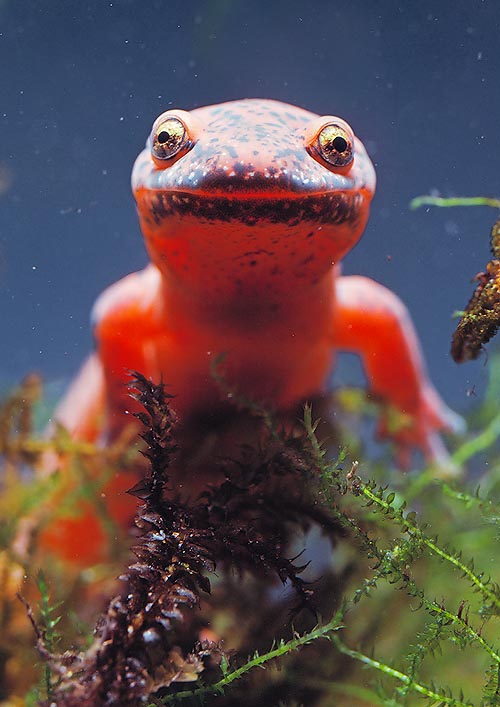
Some Caudata have eyelids, others don’t and some are blind © Giuseppe Mazza
The order of the Caudates (Caudata) or Urodeles (Urodela), commonly identified with salamanders and tritons, is the second as per dimensions and varieties of species, in the three orders in which the biologists have subdivided the class of the Amphibians (Amphibia). The smallest is the order of the Apods (Apoda), the largest and most variegated one is that of the (Anura).
Until the year 1950, and still now, some biologists of the International Code of Zoological Nomenclature (ICZN, one of the scientific societies in charge of the biologic taxonomy), talk of a fourth order, that of the (Meantia), or Trachistomata, proposed in 1815 by the biologist Rafinesque, which included animals such as the Greater siren (Siren lacertina). But nowadays, after the most accepted taxonomy, this species is integrated into the caudates, member of the family of the Sirens (Sirenidae).
Also in this case, like for the Anura we shall give, with the taxonomic classification, also some information about the numerous species characterizing the order, whilst specific details will be furnished in the single texts
The compound word Urodeles (Urodela), comes from the old Greek and means “with well visible tail”, and also the recent name of the Caudates (Caudata) clearly refers to this. All the members of this order have in fact, like the salamanders and tritons, tail with triangular section, in some cases very long and robust, with a segmented musculature (V-shaped myomeres). A characteristic which morphologically differentiates them at once from the toads, frogs and tree frogs (Order Anura), tailless, but the Tailed frog (Ascaphus truei) where anyway, the same is very much reduced.
Unlike the Anura, which have hind limbs very much developed for the bouncing gait, and the Apoda or Gymnophiona (classified in the past as Caeciliforma) completely lacking of limbs, the Caudata have usually four well developed legs of analogous shape, even if we shall see that the are also, following to particular evolutionary and ecological adaptations, species with more or less reduced legs, or completely atrophied. The skin is well adhering to the body and “naked”, but also in this order it is always more or less rich of glands secreting mucus (muciparous) and glands secreting substances which are toxic for the predators (granular). The pectoral girdle is in good part cartilaginous.
In its whole, the form of the body recalls that of the Lacertids (Lacertidae) a family of reptiles (Class Reptilia) afferent to the order of the Squamata, but there are also similarities with the snakes (Suborder Serpentes), and the Anguilliforms (Order Anguilliformes), as is the case of the Sirenidae and of the Amphiuma means.
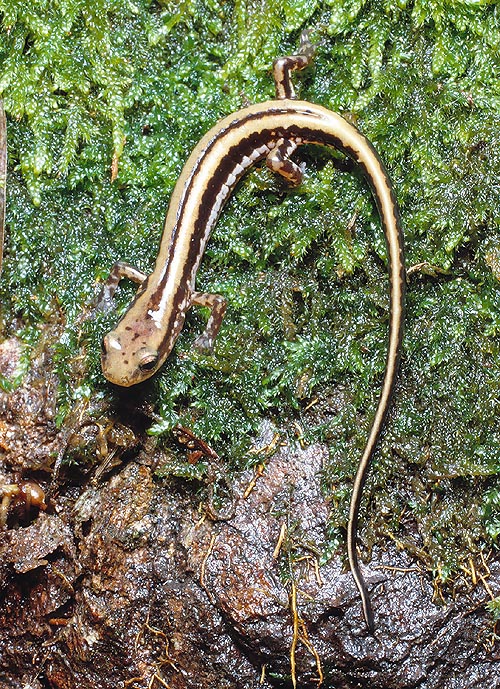
Eurycea longicauda guttilineata. Many Caudata recall the lizards © Giuseppe Mazza
The resemblance with the lizards is more in line with the terrestrial species, whilst in the numerous aquatic species the tail is strongly compressed on the sides and is often furnished of ample natatorial membranes.
Also these amphibians have an indirect development, through metamorphosing larva, but whilst in the Anura the gills of the larvae are mostly internal, here we also find three pairs of outer gills, which are conserved by some genera during their whole vital cycle. Sometimes the adults have neither gills, nor lungs, and can breathe only through the skin and the buccal mucosa. Usually, it is matter of “gonochoric” animals (with distinct sexes) and the fecundation may be external (exogenous), or internal (endogenous).
Some species of Caudata,belonging respectively to the families of the Proteids (Proteidae) and the Plethodontids (Plethodontidae), have an advanced adaptation to the “hypogeous” aquatic life: pools in caverns and caves.
They have no eyes, are depigmented, usually of modest size, with a very low metabolic rate. The type of nourishment depends on the flux of nutrients carried by the water courses penetrating these geological structures, or which decant in these locations. And also their modest reproductive ratio is connected to this.
But also in the world of the Caudata there are very developed species, such as the Japanese giant salamander (Andrias japonicus), greedy predator, more than 1,5 m long.
All the species belonging to the Caudata are carnivorous. They nourish of invertebrates (annelids, oligochaetes, molluscs) or, in some cases, like for the Japanese giant salamander (Andrias japonicus), also of small amphibians, fishes, reptilians and other vertebrates of modest shapes.
From the haemotologyc point of view, they are characterized by mature, elliptic and very big, nucleated, red blood cells, unlike those of the Mammals (Mammalia), specifically the Primates (Primates human being included, where they are discoid and concave, small and anucleate (without nucleus) at the mature state of erythrocytes.
Taxonomy and species
Until further notice, the biologists assemble these animals in eight families and little more than 300 species.
Family of the Cryptobranchids (Cryptobranchidae), giant salamanders, 3 species.
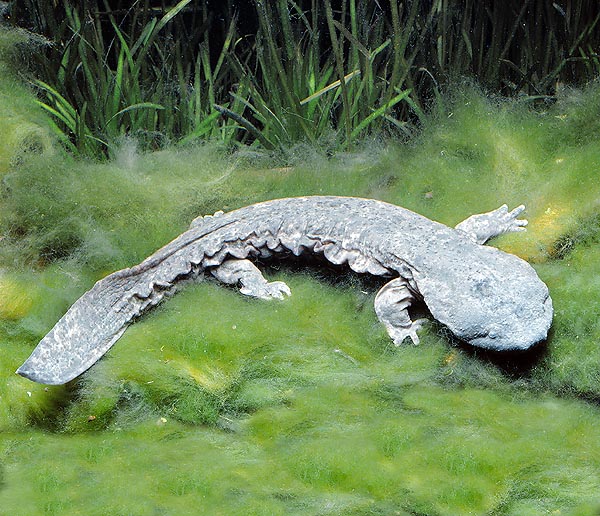
The Andrias japonicus (picture) and the Andrias davidianus are the greatest extant salamanders © Mazza
They are primitive amphibians, exclusively aquatic, with adults without gills and mobile eyelids.
To this family belong the Japanese giant salamander (Andrias japonicus), called also Megalobatrachus japonicus by some biologists, mostly of Japanese school, which its 150 cm of length competes with the quite similar Chinese giant salamander (Andrias davidianus) for the size of the biggest extant amphibian.
It lives exclusively in the mountain districts of the Japanese island of Hondo, where it is called “hanzaki” by the indigenous peoples and frequents mostly the cold waters of the mountain streams, avoiding the light and hiding in the gorges of the submerged rocks.
It is a torpid animal which spends most of its life in the immobility, and decides to move only during the night, when forced by hunger. Small fishes, amphibians and crustaceans are seized by a sudden dart and swallowed almost whole.
The body is compressed on the upper part, with graceful sides, which show a big cutaneous plica, and an unusually wide and flat head.
The primitiveness of its morphology manifests in the absence of gills, with short legs if compared with the fat body, which almost recall a small varanus. The forelegs have three toes, whilst the hind ones have four of them, all palmate, well adapted to the aquatic life, like the tail, strongly compressed on the sides, with a showy swim membrane. The skin is densely covered with warts, especially in correspondence of the head. The colouration is greyish brown, with darker spots with blurred contours.
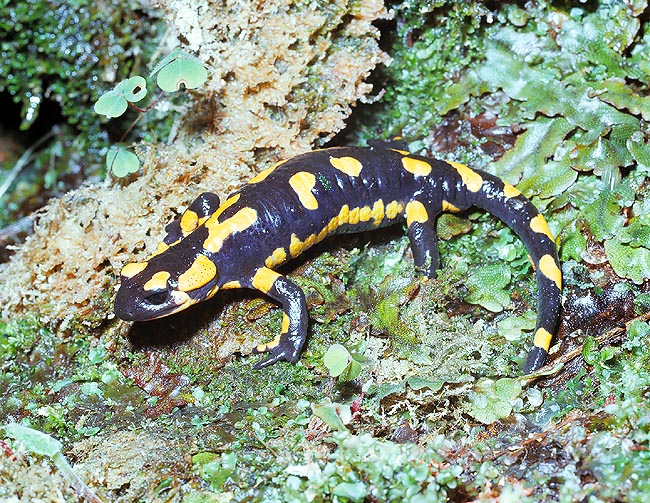
Like many amphibians the salamander skin is toxic, but beliefs about this are exaggerate © Giuseppe Mazza
The eyes are very small, and the nostrils completely invisible.
The breeding time coincides with the full summer season.
The females lay few hundreds of gelatinous, roundish, diaphanous eggs, a couple of centimetres broad, agglutinated to form a cord.
After the fecundation, the male surveys them for several weeks, till the hatching.
The larvae, about three centimetres long, with rudimental legs, resemble to the adults, but have the typical tufts of gills on the sides of the head and the mouth placed in the lower part of the snout.
The larval life may last even 3 years. When they are more than 20 cm long, they lose the juvenile characters and transform in adults.
The biological data we know are coming from studies made on individuals in captivity, as following these animals in the wild is extremely difficult.
We know, for instance, the some Japanese giant salamanders, kept in captivity, have lived for more than sixty years, and that in the Amsterdam Zoo a specimen has exceeded the age of 50 years, but this does not mean that this species may be even more long-lived.
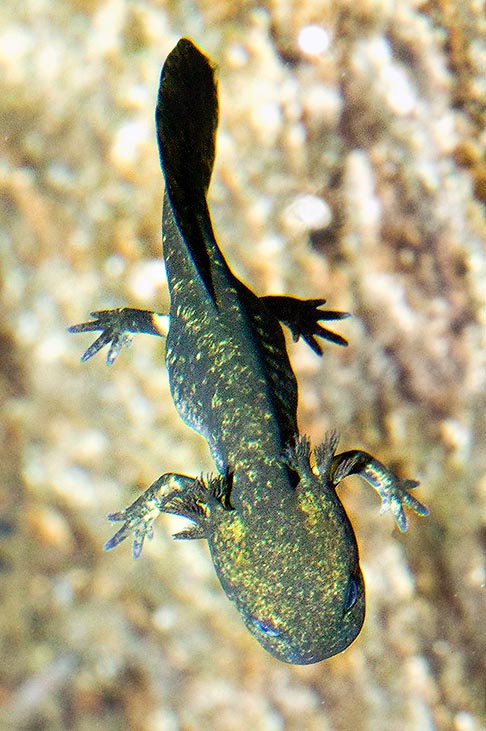
Swimming larva of Salamandra salamandra © Giuseppe Mazza
From the ethnological point of view, the biologists have noted that, until the mid twentieth century, these animals were hunted by the natives, especially because they swallowed the bait like the fishes.
They did appreciate their flesh, and the same was very much sought for, in spite of the skin being rich of poisonous glands.
Presently, the species has somewhat rarefied, has joined the red list of endangered species and is protected by the IUCN and the CITES.
The trade is allowed only among specialized structures, zoological gardens and aquatic parks, where the biologists may study it and increase its population.
The same applies to the Chinese giant salamander (Andrias davidianus), threatened by the water pollution caused by pesticides and fertilizers, by the never-ending hunting and by its alleged medicinal virtues.
Its specimens exceeding the 180 cm and with more than 30 kg of weight have nowadays become impossible to find, and it stands, without any doubt, between the most endangered amphibians in the red list and is now strictly protected also in China (Red Data Book of Endangered Animals – Zhao 1998), which guards it in various reserves and has been introduced in Taiwan too.
Like the Japanese giant salamander (Andrias japonicus), it lives in lakes, rivers and mountain streams with clear waters, usually between the 300 and the 900 m of altitude.
It nourishes of insects, fishes and amphibians seized by perceiving with special sensor nodes placed along the body, the vibrations caused by the preys. Its eyesight, in fact, is very poor.
It may be easily distinguished from the Japanese species due to the tubercles on its head and throat, smaller and in pairs; whilst in the first species they appear to be placed in a disorderly way; here they form, on the throat, precise parallel lines.
The females lay even 500 eggs into submerged cavities surveyed by the male as it happens for the Japanese giant salamander. They hatch in a couple of months, but few of them may reach the adult size. Luckily, we have been able to reproduce it in captivity for alimentary and commercial purposes; in this way, paradoxically, the main cause of its decline is now saving the species.
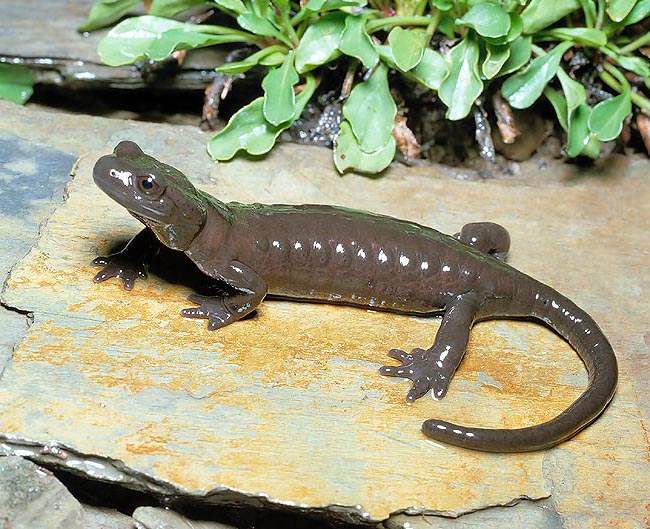
The Salamandra atra lives in the mountains and generates a maximum of two kids © Giuseppe Mazza
The third Cryptobranchidae species is the less famous Cryptobranchus alleghaniensis of the USA, smaller, but reaching anyway the most respectable size of 70 cm.
Family Hynobiids (Hynobiidae). Called also Asiatic salamanders, they stand among the less studied forms of the order of the Caudata.
Strictly related with the family of the giant salamanders, in the suborder of the Cryptobranchoidea, they have about 30 species, living in oriental and central Asia, in mountainous regions, at high altitude. They have primitive characters and mobile eyelids.
Some species are aquatic, others have perfectly adapted to the terrestrial life, as shown by the renal emunctory system, which is the most efficient of the order.
The eggs are fecundated externally by the males and are guarded until hatching by both parents. When the larvae live in cold, well-oxygenated waters, the external gills often appear to be reduced. An example is given to us by the Central Asian salamander (Ranodon sibiricus) 20-25 cm long, which lives in the mountain streams in the central-southern regions of Asia.
Family Salamandrids (Salamandridae), tritons and salamanders, 42 species.
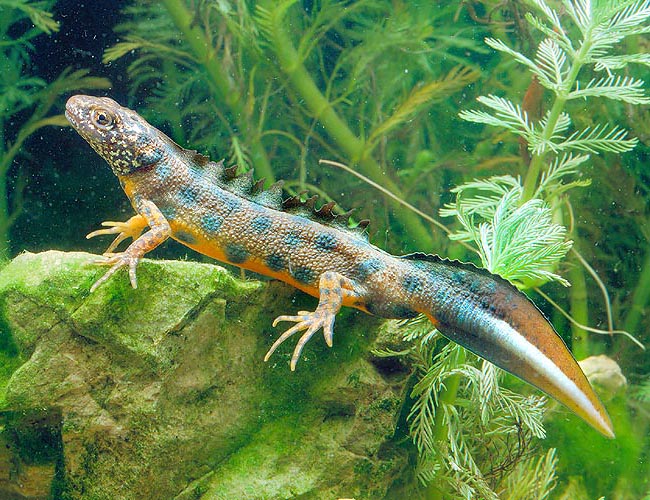
In the Triturus cristatus males the crests and the colours disappear after the marriage © Giuseppe Mazza
The members of this family, mostly spread in the Old Continent, have all their teeth driven into the palate. They are always without gills.
A typical example is the Common salamander or Yellow-black salamander (Salamandra salamandra) called also, by some biologists, Salamandra maculata.
Very common in northern Italy, it lives among the grasses and mosses in the not elevated humid zones of all Europe, North Africa and Asia Minor.
During the winter, being ectothermous like all the amphibians, hibernates, piling up, often also in a considerable number, in some gorges.
It cannot swim and delivers, with caution and in reverse, in the running water, offspring equipped with gills.
It is therefore matter of an ovoviviparous animal.
It is called also, thanks to a famous legend, the “Devil’s messenger” as, after what was written also by Pliny the Elder, it should not die in the fire, and its very toxic cutaneous secretion might kill a man. The great poet, historian and philosopher added also that it emitted saliva from the mouth, which, if touched, should push over the mantle and the fur of an animal, causing even cutaneous ulcerations.
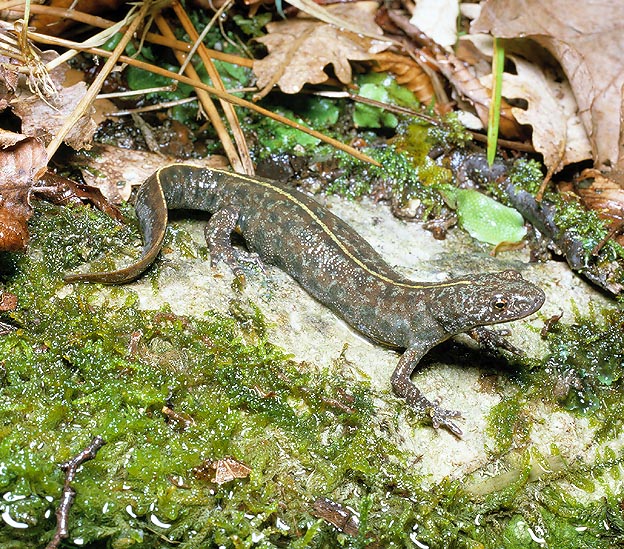
Triturus cristatus females, bigger, keep always the same attire © Giuseppe Mazza
The XVI century alchemists, who were looking for the “philosophers’ stone”, thought that by pouring molten lead on the ashes of a carbonized salamander, some gold might be obtained.
And during the XIX century, a young English lady, married to an oldish and rich London trader, but in love of a poor coetaneous, in order of getting rid of her husband and inherit his wealth, should have put, every day, pieces of salamander in the stew and the soups she was preparing for the husband for poisoning him, succeeding in her aim.
This one and other stories have generated atavistic fears on this poor animal, totally unaware of the human considerations.
But the whole of these poppycocks, as often it happens in the legends, has a fund of truth.
As a matter of fact, the Salamandra salamandra, by means of its “granular glands”, secretes a viscous alkaline substance, irritating for the predators, in which an active principle has been identified, an alkaloid called “samandaridine”, which depresses the respiratory system.
When inhaled by a mammal or by the man, it should have the same effect as the venom of the cobra! When taken through the mouth, by a dog or a human being, and then reaches the stomach passing through the oesophagus, it causes only burning, irritation, nausea to vomiting, but it is not venomous. If, on the contrary, it is inoculated by intravenous bolus in a dog, after a phase of asthenia, leads it quickly to death, in less than 30 minutes!
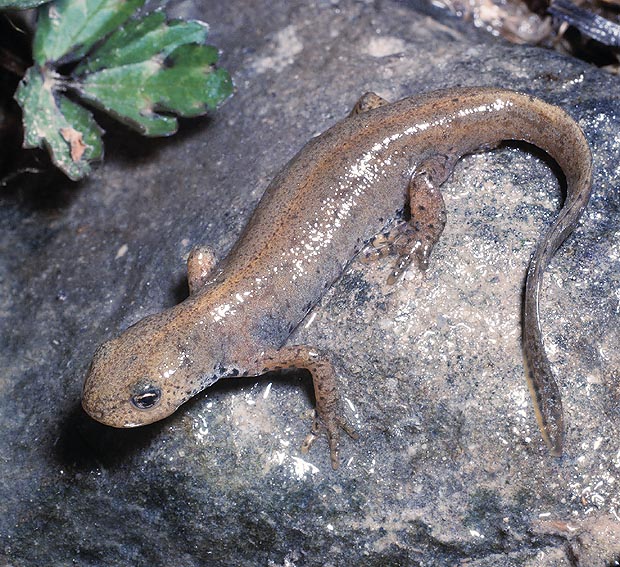
Triturus alpestris females too have a modest look called “eclipse” livery © Giuseppe Mazza
More distinctly mountainous, is the Alpine or black salamander (Salamandra atra), easily distinguishable from the previous one due to a more slender shape, the reduced dimensions and the totally melanistic coloration of the body and of the head.
But there is a subspecies, the Salamandra atra aurorae, with big dorsal dots, often united, of a nice bright yellow colour.
The gills, absorbed by the newborn before its birth, are practically the same as those of the Salamandra salamandra, but bigger.
Nowadays, we know that it is an ovoviviparous species, which means that it delivers the offspring (at the maximum two), already shaped and does not lay eggs, as the same are incubated in the oviducts.
This was discovered in the thirties by the German biologist Scheiber, who studied it both on the field and in laboratory, observing that the bigeminal births often may be also single, thing never seen in other salamanders.
In fact, even if by each cycle of pregnancy several tens of ovules rich in yolk do reach the oviduct, a maximum of one or two of them will develop.
This or these embryos are called dominant (embryonal Darwinism), vis-à-vis the potential others, because they nourish of the yolk of the nearby eggs, not fecundated or aborted.
They metamorphose inside the oviduct, and come out absolutely similar to the adult, but with very modest dimensions, and will reach the physiologic size through consecutive allometric growths.
Between the terrestrial salamanders, two are present also in Italy, where, in fact, they are endemic: it’s matter of the Spectacled salamander (Salamandrina terdigitata), 10 cm long, and the Sardinian Triton or Euproctus (Euproctus platycephalus), which reaches the 15 cm.
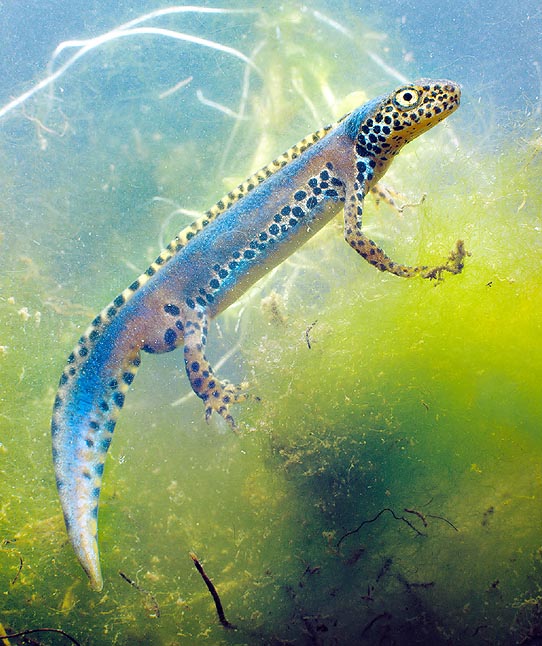
A Triturus alpestris apuanus male in its splendid nuptial livery © Giuseppe Mazza
The first has an Apennine distribution, south of the Volturno River, up to the Pollino National Park in Basilicata, where it is found close to the Frido creek at Peschiera. It has a body with an orange colouration in the lower abdomen and in the tail, whilst the trunk and the head are white-black variegated.
The second species, as the name asserts, is endemic to Sardinia; its colouration may vary from the brown-olive green to the pink; however, in both cases, the livery is strongly maculated.
On the contrary, the properly called Newts, (genus: Triturus), recognizable for the strongly compressed on the sides tail, are partially terrestrial.
The biologists gave them this name in reference to the marine Greek mythological god Triton, with human trunk and head, whilst the lower part of the body is fish-shaped, with a long tail, engaged in blowing inside a twisted shell.
This genus is particularly spread in the boreal hemisphere, very common in Europe, mainly in Italy, not so much as frequency, but for the variety of species. But it is also present in North America and in northern Asia.
The size of the newts is usually smaller than that of the salamanders, but the livery is often spectacular, with variations of shape and colours which depend on the species, sex, age and season. The legs are rather long, furnished in front with four toes, and behind of five.
Besides the teeth implanted on the maxillary arches, they have two series of vomer-palatine teeth. The tongue, which may be remarkably turned out, is short, oval and rounded, free only at the margins. They nourish of annelids, oligochaetes, crustaceans, molluscs and small fishes.
They have a reserved character and it is not easy to find them in the wild, if not in the periods and in the locations rather wet when they expose themselves more, as they have the tendency, during the driest periods, to live hidden in rocky holes, under the roots of the trees, under layers of decomposing foliage, camouflaging with their livery.
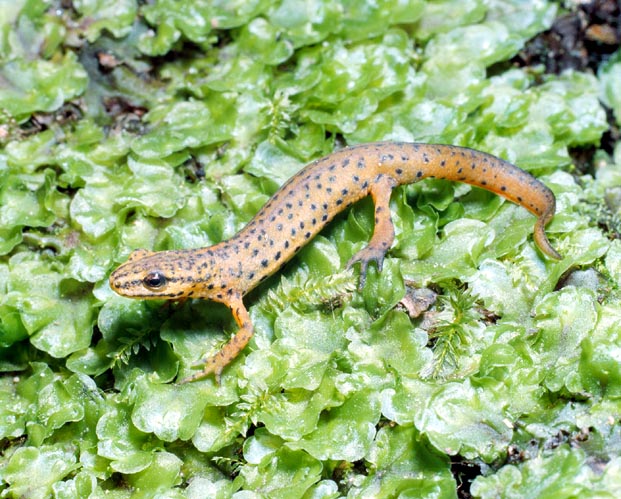
The Triturus vulgaris dalmatinus is an Italian subspecies © Giuseppe Mazza
They are oviparous, and for this reason they return stably to the water, during the mating where the nuptial parades of the males take place, and will remain there till when all the parental obligations have been completed.
The males, which have cloacal region more turgid than the females, by the wedding time often ornate with a showy serrated crest, which almost runs from the nape to the caudal extremity and which disappears completely by the end of the mating season.
The “eclipsal”, absolutely unchangeable, livery of the female contrasts the “nuptial” attire of the male (formation of crests, chromatic changes of the livery).
The rituals, in the different species, are quite bizarre and complicated, and have been described by several biologists, who have photographed and filmed them.
They consist in grotesque contortions of the male which, in the meantime, hits the female, in order to become interesting to its eyes.
The entire reproductive cycle takes place in water, where happens, with some rituals, the deposition, done by the male, of the “spermatophore”, a capsular structure containing its spermatozoa.
This is collected by the female with the mouth, and placed, about one week later, in the cloaca. Only by that time takes place the deposition of the fecundated eggs, oval or roundish, and with a diameter of a couple of millimetres, covered by a mucilaginous involucre. They are emitted gradually, over a few days, and fixed to the leaves of the submerged aquatic plants.
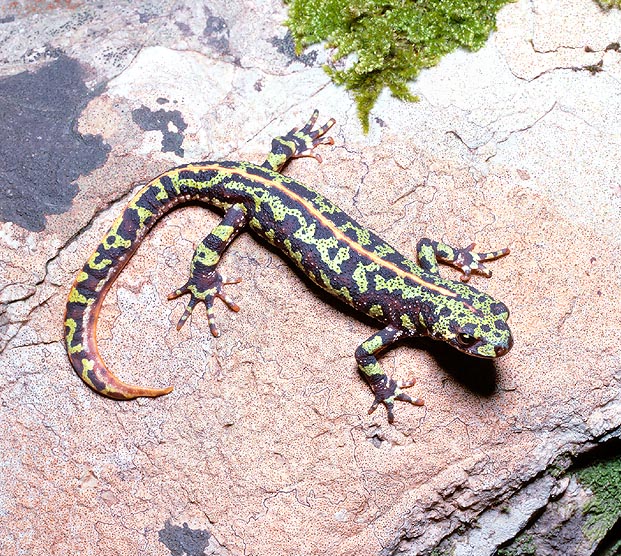
Elegant attire of Triturus marmoratus female, spread in France and the Iberian Peninsula © Mazza
It may happen that, due to various reasons (environmental, nutritional, etc.), the fecun- dation does not happen in the aforemen- tioned timings, but this is not a problem, because inside the “spermatophore”, the sperm lasts a long time, without getting any damage or losing the fecundating vigour.
Once their duty completed, the adults get out from the water, all the males lose their crest (phenomenon called “eclipse”) and they resume their normal life, partly terrestrial; it is not uncommon, however, that they may linger in the water, even longer, spending even the whole winter season.
Moreover, the embryonal development has a variable duration; if the environmental and seasonal conditions are optimal, it may be completed in the period of one month.
The appearance of the newborn larvae, which upon their birth are one centimetre long, is, to say the least, characteristic; almost diaphanous, have a slender and short trunk, the head is enormous with big eyes and have a natatorial membrane along their spine. The forelegs are little developed, and on the sides of the body they have three pairs of small external gills with expanded tufts. Furthermore, on the sides of the body, we see a structure, analogous to the “lateral line” of the fishes, perhaps a phylogenetic vestigial residual, which will disappear in the adult specimen. The hind limbs are missing completely (or are just outlined) and will form later on.
These larvae are extremely greedy, due to a very accelerated metabolic rate, and eat crustaceans and planktonic animals of whatever sort, so that in a few months they complete their development, losing the gills, assuming the adult morphology and getting out from the water.
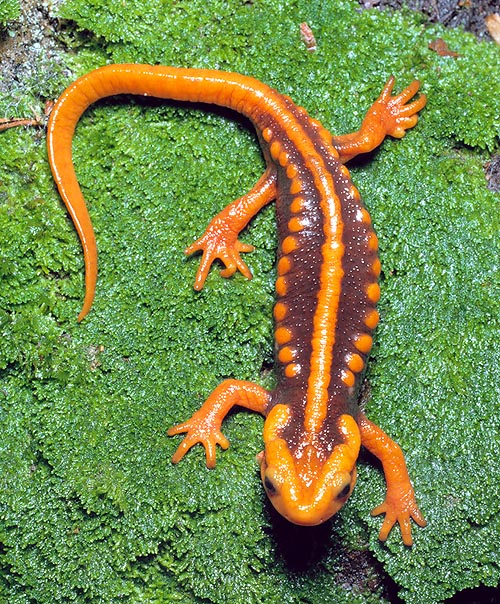
Tylototriton verrucosus. A spectacular Asiatic salamander © Giuseppe Mazza
The sexual maturity is reached by the fourth year of life, both in males and females.
The Great crested newt (Triturus cristatus) is one of the most beautiful and known Italian species; usually it appears with a dark brown back, more or less variegated, and lower parts, included the belly which is bright orange, on which are evident black circular dots. The natatorial membrane extends also on the back, where it is more or less notched.
The males may be 16 cm long; the females may be 19-20 cm, with a clear sexual dimorphism.
It is endemic to Austria, Istria, Switzerland; and in Italy the Tyrrhenian limit in its western distribution is represented by Liguria. To the South, it is not present below the 39th parallel.
The typical reproductive habitat is represented by still, “lentic”, waters, natural and artificial of various sizes, from small ponds to lacustral basins. It may be easily bred in the domestic aquaria or in laboratory, and therefore is utilized for studies of embryology and biology of the development. But we have to be cautious that the pool is not overcrowded and that the nutriment is sufficient, in order to avoid phenomena of cannibalism.
The males perform spectacular nuptial parades in the breeding season, which usually falls by late winter, but it may start also by late autumn.
Another Italian species is the Common or spotted newt (Triturus vulgaris) with the subspecies or race Triturus vulgaris dalmatinus. Smaller than the crested newt, it does not exceed the 10 cm of length. It lives in Europe and western Asia. In Italy, it’s endemic to Friuli.
Also in this instance, during the reproductive time, the male has a crest on the back and the tail flattens vertically to facilitate swimming. These morphologic characters, acquired for the occasion, are called “sexual attractors of transitory-seasonal sexual dimorphism”.
We have then the Italian newt (Triturus italicus), with a colouration on the back tending to the green, always spotted of black. It resembles to the previous, and replaces it, as species, in the southern regions. Finally, in the mountainous zones, we have the Triturus alpestris, called by some authors also Mesotriton alpestris, which measures about 6 cm.
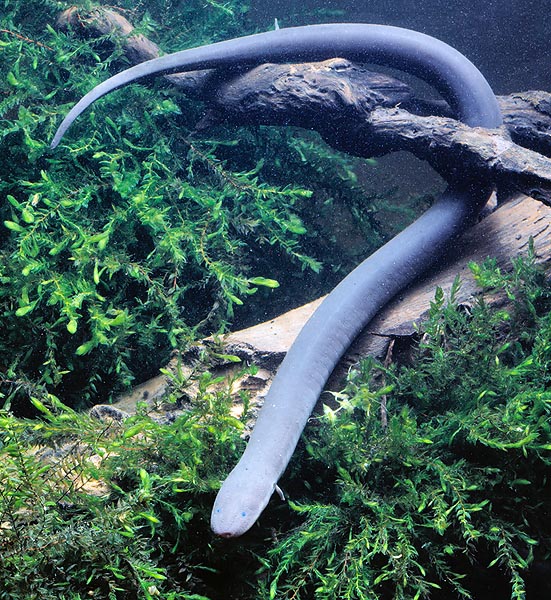
Amphiuma means. One metre long and almost non-existent legs © Giuseppe Mazza
It is frequent in Italy, on the central-eastern Alps, the Ligurian Alps, in some isolated locations in the Aosta Valley and in the Po Valley, where we find the race or subspecies Triturus alpestris alpestris, on the northern Appennines, in some locations of the Tuscan Appennines, in one location in Lazio, where lives the race or subspecies Triturus alpestris apuanus, and in three points, on the Calabrian range, with the subspecies Triturus alpestris inexpectatus.
The races Triturus alpestris apuanus and Triturus alpestris inexpectatus live in the water all the year round, whilst the individuals of the other races hibernate and estivate on the mainland.
The reproductive period usually begins in February (March-April for the northernmost populations) and already by the beginning of March we may find the eggs in the reproductive locations. The larvae have dimensions which may vary from 3 to 6 mm.
In France and in the Iberian Peninsula, it is easy to meet the Marbled newt (Triturus marmoratus) which may reach the 16 cm of length.
Between February and April, it frequents ponds, pools and ditches for reproducing, but it mainly carries on a terrestrial life, with hunting trips by the nightfall or when it rains.
The female has very elegant attire, green and black, with a long orange dorsal stripe. But the record of the spectacularity goes by sure to the exotic Tylototriton verrucosus.
At home in the wet mountainous forests of southern China, Burma, Assam, Bhutan and Sikkim, it stands out for its showy orange-red colouration, with bony crests and tubercles, in contrast with the brownish-black background. It almost reaches the 20 cm of length and leads immediately to think to the dragons of the Chinese festivals. Active mainly at night, in the litter of the underwood, it reproduces in marshes and rice fields in March-April, when the rains come. During its nuptial parade, the male, before releasing the spermatophore, hugs the female holding it on the back with the forelegs. The female gets it, as usual, and lies from 55 to 100 eggs. The larvae take about one year for reaching the 4 cm of length and completing the metamorphose.
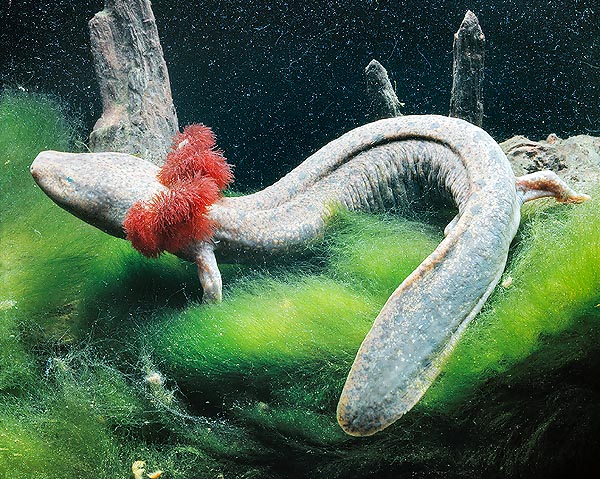
The Necturus maculosus keeps some showy red branchiae for all its life © Giuseppe Mazza
Family Amphiumids (Amphiumidae), amphiumas, counting three species.
These caudates, with their thin and blackish-green body, with very small legs, live in the swampy and stagnant waters of the eastern zones of USA and are by sure very interesting animals for the zoologist biologists.
The Two-toed amphiuma (Amphiuma means) of eastern USA with more than a metre of length, is, after the giant salamanders, the second greatest extant amphibian.
The eel-like body, practically cylindrical, has about sixty rib furrows. The legs, both fore and hind are almost inexistent, with two small toes. The head is elongated, slender and laterally compressed, and immediately behind we notice some gill slits.
The eyes do not have eyelids, are very small but sufficient for hunting in the darkness small fishes, frogs and shrimps. The amphiumas, in fact, doze during the whole day, motionless, camouflaged between the submerged vegetation, and leave their hideouts only by the nightfall.
Not much is known about their reproductive biology, apart from the fact that the female lays even up to 200 eggs, united in long gelatinous cords, in a small dimple dug in the muddy bed where it lives. Then, rolls up over them and protects them for about 5 months, until hatching.
There is also a subspecies with three small toes per foot: the Amphium means tridactylum .
Family of the Mudpuppies (Proteidae) with three aquatic species, without eyelids, conserving all their life long their larval form.
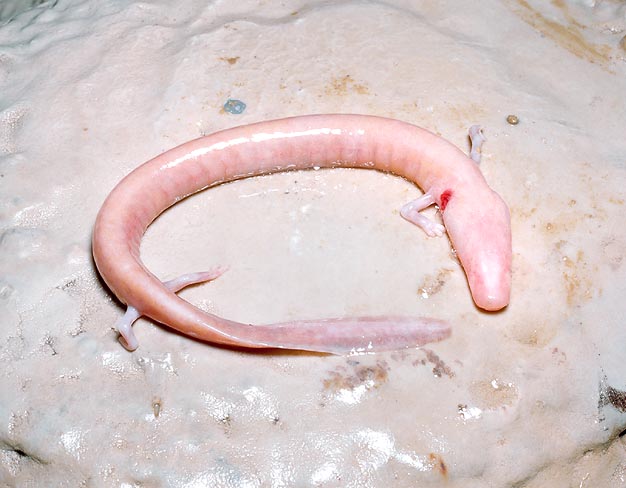
The Proteus anguinus has lost its eyes because living in the darkness and in ground waters © Giuseppe Mazza
An evident example is the Waterdog (Necturus maculosus) 20-40 cm long, with great feathery reddish-brown gills, at home in the lakes and the water streams of the central-eastern regions of North America where the submerged vegetation is abundant.
It has a brown-grey colouration, with dark dots, often bluish, and an elongated head with small eyes. The limbs, short and stocky, have four toes. The tail, highly compressed, is furnished with dorsal and ventral fins.
During the day, it hides between the plants or under the rocks, whilst during the night it goes hunting shrimps, insects and small fishes.
The female can lay even 200 eggs, which are stuck on the lower side of the submerged stones.
Also our Olm (Proteus anguinus), animal without eyes, belongs to this family, and the Texas blind salamander (Typhlomolge rathbuni), which lives in the underground waters of the Karst caves.
Endemic to north-eastern Italy and the coastal regions, from Istria to Monte Negro, it is the only European troglobitic vertebrate. Due to the habitat where it lives, also its skin is depigmented, but has a pale-pink colour, rather than albino, on which stands out the “red” of the long ramified gills, placed on the sides of the neck even when adult. In this species, which does not exceed the 30 cm, the forelimbs have three toes, and the back ones two. It nourishes of molluscs and small crustaceans; the females lay from 10 to 70 eggs on the lower side of the submerged rocks.
Family Ambistomids or Amblistomids (Ambystomidae), forms, called Axolotl, which reproduce without metamorphosing.
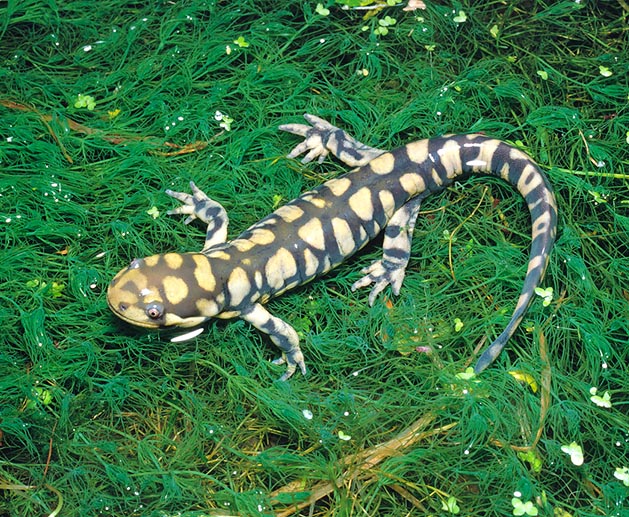
A metamorphosed Ambystoma tigrinum mavortium © Giuseppe Mazza
There are 32 species spread in central and northern America. The fecundation is internal, as it happens for the most evolved families of the Caudata.
A typical member of the family is the Mexi- can axolotl (Ambystoma mexicanum), about 10 cm long, living in the lakes. Usually it keeps the larval features for all the life, reproducing at this stage (neoteny), but when the habitat becomes, suddenly, dry, in order to survive it completes its metamor- phose: the gills disappear and the animal ventures in the dry land.
This “neotenic” condition, which may ensnare the animal in a larval status for the whole life, seems to be related, at least for some biologists, with an extremely low concentration of “iodine” in the water where the animal lives, element which is necessary, from the endocrine point of view for completing the metamorphose.
So that if some Axolotls in captivity are given to eat some fragments of bovine thyroid, or of another vertebrate, they rapidly metamorphose
An analogous species is the Tiger sala- mander (Amblystoma tigrinum by some authors, like Brehm, indicated with the name of Ambystoma tigrinum), about 20 cm long like our Fire salamander (Salamandra salamandra), and quite similar in the colours, with its often black coat with yellow spots.
The tiger salamander has terrestrial habits and enters the water only for laying 50-100 eggs, from which will come to life larvae with gills, which normally metamorphose in one year.
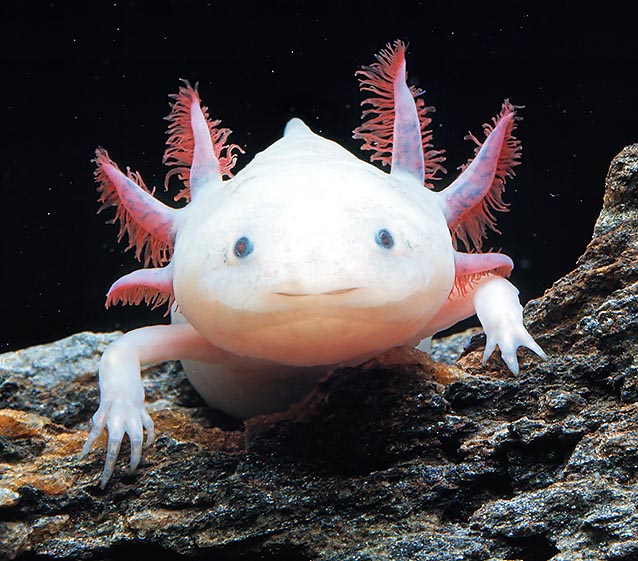
Sometimes the Ambystoma tigrinum doesn’t metamorphose and is called Axolotl © Giuseppe Mazza
But in some specimens we may have the already cited phenomenon of the “neoteny”, and these individuals with gills, called “Axlotl”, go on in carrying aquatic life.
Terrestrial only is, on the contrary, the Marbled salamander (Ambystoma opacum) living in eastern USA, from the south of New England up to the North of Florida and to the West up to Texas and Illinois.
Its name is originated by the several black spots on clear background, which remem- ber the drawings of the marble, and it may reach the 13 cm of length.
By late summer, in the humid nights, they migrate en masse towards the more or less dry ponds where they are used to repro- duce.
The males go there few days before the females and the fecundation takes place on the dry land. Males and females dance together, rubbing till when the females recover the spermatophores.
The eggs are laid out from the water, in small holes or at the shelter of stones, trunks or dead leaves. The female surveys them and turns them over for avoiding molds, awaiting the heavy autumnal rains which will fill up the ponds where the larvae will be able to develop and effect their metamorphose. When the winter cold comes, they hibernate, but if it doesn’t rain the eggs may wait for the spring rains.
The Blue-spotted salamander man (Ambystoma laterale) is native to the great lakes of Ontario and Quebed, in Canada and to those of the North-East of USA. Its length varies from 8 to 14 cm, but we have to add that the 40% of this length concerns the tail.
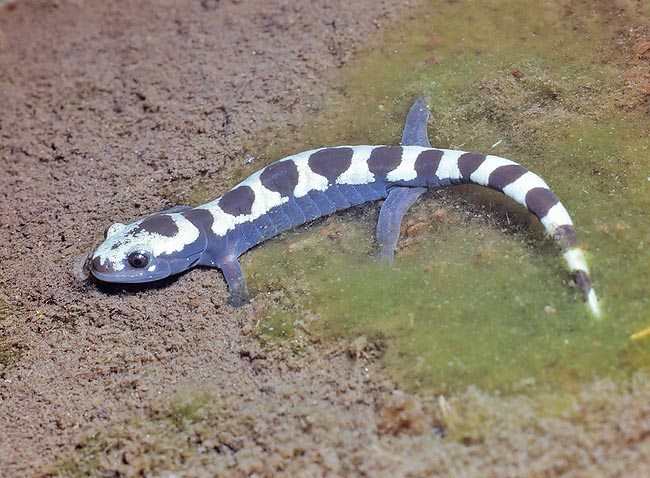
The Ambystoma opacum, because of its drawings, is called also Marbled salamander © Giuseppe Mazza
The typical habitat is that of the “deciduous” forests and of the swamps in the woods of the north, but they can be found also in the “conifer” forests and in the ponds of the Taiga.
The Spotted salamander (Ambystoma maculatum) has a dark skin with electric blue reflexes and round yellow spots which cover also the head.
They may have a length up to 18-25 cm and have very bulging eyes with eyelids.
Also this species is native to the deciduous forests of the eastern part of northern USA and Canada, but it may be met also in New Scotland, Georgia and Texas. Inside these biotopes, it prefers, for the reproduction, rather limpid water surfaces, where the females will lay groups of even 100 eggs.
These salamanders spend most of their day in dens dug in the humid soil, and get out for hunting earthworms and small preys only at the nightfall or when it rains.
As the name suggests, is of big size, on the contrary, the California giant salamander (Dicamptodon ensatus) which may reach the 30 cm of length. It has robust head and structure, great bulging eyes and an elegant brown livery with several blackish marbling.
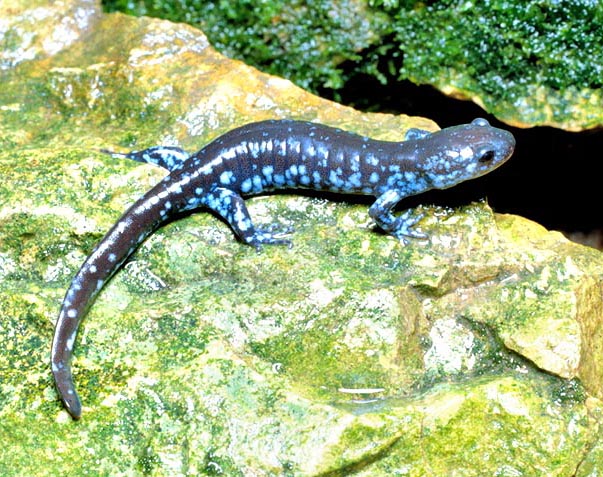
Ambystoma laterale. Who ever said that a blue salamander doesn’t exist ? © Giuseppe Mazza
The adults, mainly terrestrial, common in the humid forests of the extreme western regions of North America, from British Colombia to California, are very greedy. The do not look only for insects and earthworms among the leaves of the under-wood, but do not hesitate in attacking small amphibians and even young snakes.
In spring, for the breeding season, they move close to the nearby creeks, where the females lay singly the eggs under the submerged stones. The larvae metamorphose after two years, as soon as they exceed the 10 cm.
Family Plethodontids (Plethodontidae). It is the family of the lungless salamanders, the most numerous family of the Caudata, with about 183 species.
Many of them are aquatic, but the adults, except the genus Typhlomolge, do not have gills and the respiration happens exclusively through the skin.
The terrestrial species are less active and consume less oxygen than those living in the mountain streams, where the well aerated waters help the cutaneous breathing.
We can find them in southern Europe, North and Central America and in the northern part of South America.
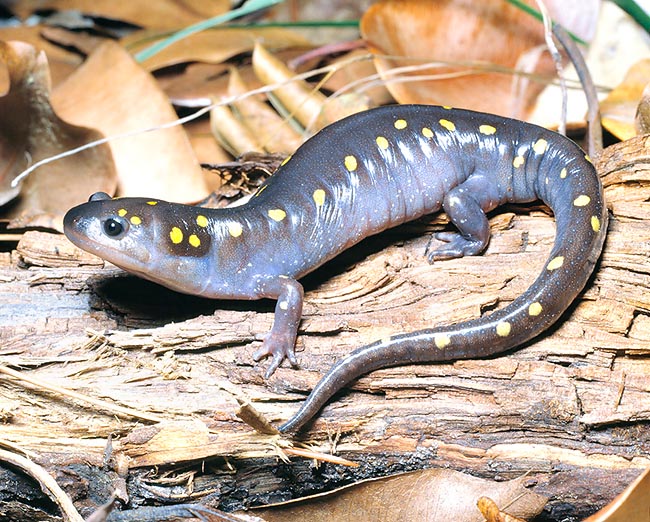
The Ambystoma maculatum is common in Canada and in eastern USA © Giuseppe Mazza
The famous Texas blind salamander (Typhlomolge rathbuni), equipped with permanent gills, lives in the water of the hypogeous pools (grottoes and caverns).
It is a cryptic species which spends all its life in a habitat totally devoid of light.
Such zoogeographic and ecologic characteristic has evolutionary caused a complete depigmentation all over the body, which has become white and the disappearance of the eyes.
It can perceive the presence of food and water by means of chemo-receptors and tactile receptors which have developed during the time thus replacing the eyesight. The adults do not exceed the 13 cm of length..
Seen the habitat where they live, not much is known about their reproductive biology. In 1923, the English biologist Dunn seized some specimens for raising them in laboratory terraria.
He discovered that the females release few eggs at a time and have some spermathecae inside which the male lays the sperms.
A second species, at first sight similar to a small lizard or an earthworm, is the Red back salamander (Pethodon cinereus).) Long from 7 to 12 cm, it lives in the litter of the mixed deciduous woods and in the conifer forests of eastern USA.
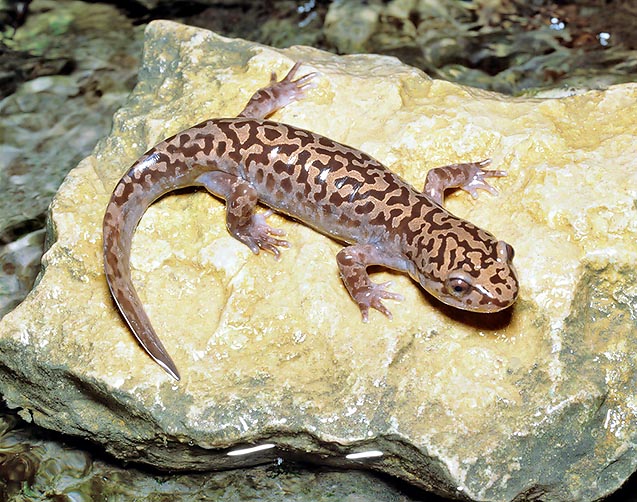
The Pacific salamander (Dicamptodon ensatus) is much greedy and may be 30 cm long © Giuseppe Mazza
The back may be red or leaden. In this second case, the whole gets a greyish tonality which explains its name. There are several subspecies. Conspicuously terre- strial, it doesn’t have an aquatic larval stage. The females stick gelatinous bunches of eggs under the stones and protect them till the hatching.
Also the Green salamander (Aneides aeneus) is exclusively terrestrial. It lives in the eastern regions of USA, hiding, during the day, among the rocks rich of cracks or under the barks of decaying trunks.
It gets its current name from a series of greenish spots on the back which stands out on a darker background colouration; it does not exceed the 14 cm.
It goes hunting during the night and mates in summer; the female lays bunches of 10-20 eggs under the rocks, surveying them carefully until the hatching time comes. There is no larval phase and the new born, similar to their parents, measure already 2 cm.
Terrestrial and also arboreal are also the odd Bolitoglossa mexicana and the Bolitoglossa dofleini .
The first, spread from Mexico to Guatemala, reaches the 19 cm and during the dry season climbs, without any effort, the trees of the forest for reaching some epiphytic plants, the Bromeliaceae, which, inside their rosettes, keep always a water reserve, which attracts also small preys such as insects and other invertebrates.
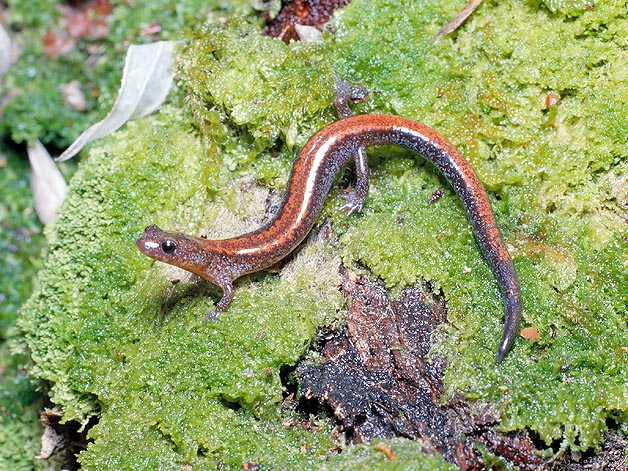
The Plethodon cinereus doesn’t have an aquatic larval phase © Giuseppe Mazza
Also in this instance, the eggs are laid in cavities which are protected and surveyed by the mother till the hatching.
The Bolitoglossa dofleini is characte- rized by brownish body and head, rather compact, robust and short tail (in % compared to the body), loves habitats such as the tropical and subtropical pluvial forests of the lowlands or even highlands of Guatemala, Honduras and Belize.
It goes without saying that these three last species are very much impaired by the human activities and that, unluckily, they appear into the red list of endangered species of the IUCN.
The Red salamander (Pseudotriton ruber), living in the eastern regions of North America, has, on the contrary, a mostly aquatic life.
Sources, creeks with cold but clean waters, but also swamps, are its habitat, but it is not rare to meet it out from the water when by night, or during the rainy days, it goes hunting insects and earthworms, which form its preferred diet.
It strikes the attention due to its spectacular red livery with several black small spots, mostly on the back. But these colours attenuate in the adults which may reach a length of 18 cm.
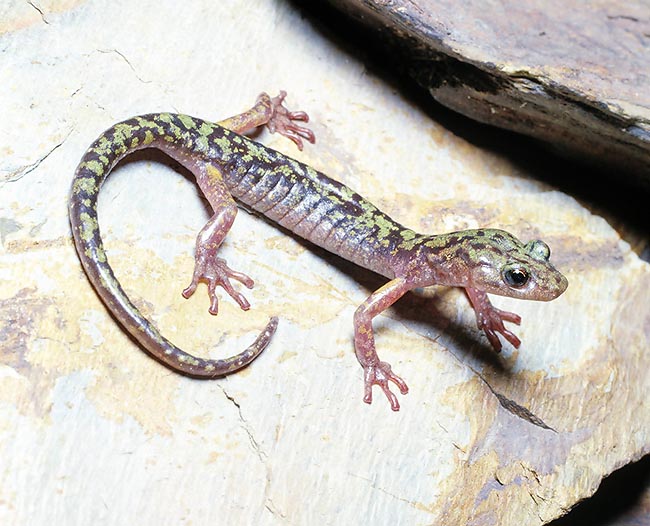
The Aneides aeneus female lays and surveys the eggs out of the water © Giuseppe Mazza
In autumn, the females lay up to 100 eggs in small cavities under the submerged stones. The larval life may last two years and when the metamorphose is completed, the young specimens measure 7 to 10 cm.
Not less flamboyant is the very showy Spring salamander (Gyrinophilus porphyriticus), diffusa dal spread from Quebec to Georgia and Mississippi, with a bright salmon red livery and a darker fine spotting.
This one too lives in the cold and clean waters of the mountain streams and is an excellent swimmer.
By night, and during the showers, it may get out for hunting on the dry land, but it never gets far away from the water, where its preferred dish is formed by small arthropods.
The reproduction takes place by late summer, when the females stick, one at a time, even 100 eggs to the hidden side of the submerged stones.
The genus Hydromantes includes 3 north-American species of California, between which the Hydromantes shastae, and two European species. They form the group of the “geotritons”.
This odd geographic distribution makes unnecessary any consideration from the bio-geographic point of view
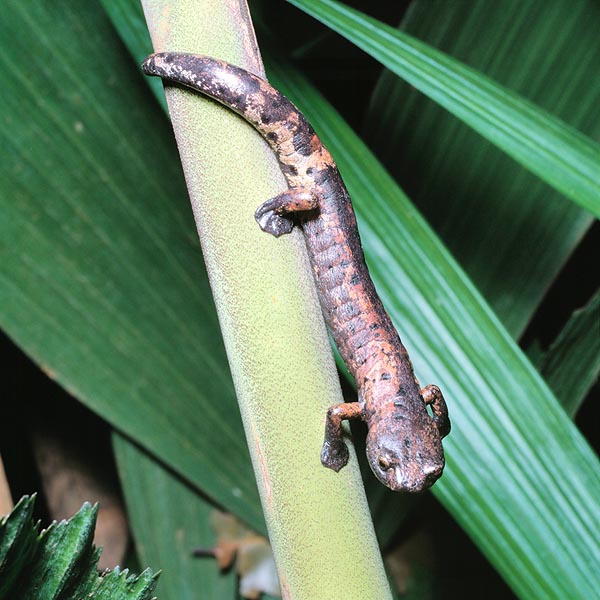
The Bolitoglossa dofleini is very good in climbing the forest trees © Giuseppe Mazza
The geotritons of the Old and the New World do not differ much between them: they have quite elongated and slender forms, palmate toes of the hind legs and a very characteristic tongue, shaped like a “mushroom” and everted, with which they seize the preys like the chameleons do.
What is more, on the chin of the male adults, we can see a body in relief of “glandular” nature, the functions of which are not completely known to the biologists, as well as it has been observed that the same adult males, during the courting, lay some spermatophores.
The head of the geotritons, with quite big and protruding eyes, is flattened, the skin is perfectly smooth and the nostrils are united to the margin of the lips by means of a quite clear furrow.
Deemed as “viviparous” till the sixties, because observed only in captivity by the zoologists of the XX century, it has been discovered during the second half of the seventies of the same century, with observation in the wild or in conditions almost identical to the “natural” ones, that in reality they reproduce by means of eggs and therefore are “oviparous”.
The name geotritons indicates us the meaning of “terrestrial tritons”; these amphibians, which, even if necessitating a very high rate of humidity, are practically “detached” from the strict aquatic habitat, also during their reproductive time.
In fact, their larvae are completely, apart the dimensions, similar to the adults, and therefore are capable to live immediately on the ground.
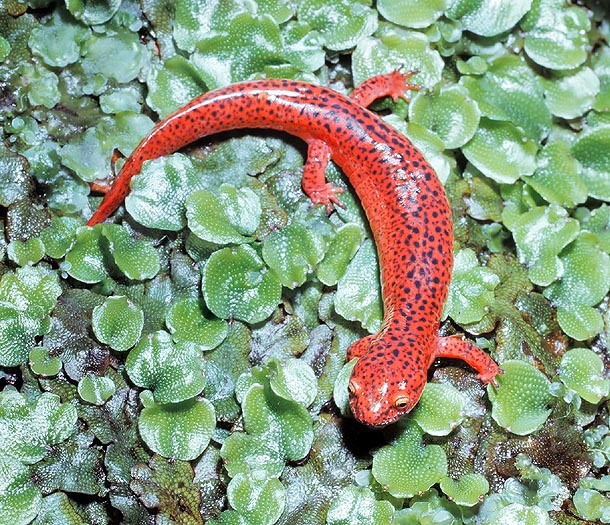
Spectacular red livery of a Pseudotriton ruber © Giuseppe Mazza
Clearly “lucifugous or photophobic” (which avoid the light) and very resistant to the low temperatures, are the two species we find in Italy: the well known Italian cave salamander (Hydromantes italicus) and the Sardinian cave salamander (Hydromantes genei).
We can find them both in the plains and in the mountain zones, up over the 1.500 m of altitude.
They spend their active life especially in the “hypogeous” and “cavernicolous”.
It is easy, however, to find them, especially if it’s the case of young individuals, under piles of rotting leaves or under the stones during the rainy weather.
During the summer heat, however, the geotritons can be found underground. In the Alpes Maritimes as well as in the adjacent French territory, lives the race or subspecies Hydromantes italicus strinatii.
It seems to be the same form which is found on the Ligurian Appenines, whilst in the zones by La Spezia, we find also the race Hydromantes italicus ambrosii.
The typical form, that is the race or subspecies Hydromantes italicus italicus, is spread in the central Appennines, from the provinces of Bologna and Pistoia, to the Morrone Mountain in the Abruzzi.
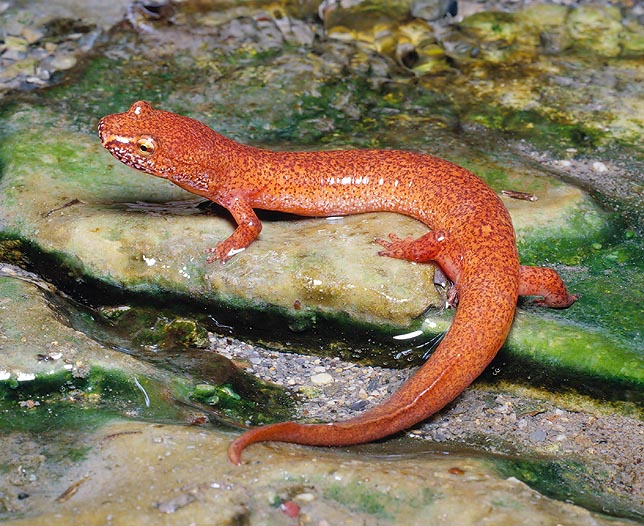
The Gyrinophilus porphyriticus prefers the cold mountain waters © Giuseppe Mazza
Further north, finally, from the provinces of Pistoia and Modena, with not precise northern limits, we find the subspecies Hydromantes italicus gorman.
Family of the Sirens (Sirenidae) with three species only, living in the waters of southern USA and in northern Mexico. They have neither hind limbs, nor teeth and eyelids. The jaws are covered by corneous plates and the gills remain for the whole life.
The name sirenidae of the family was assigned by the French biologist J.L. Buffon, already by the second half of the ‘700.
This name was coming from the similarity the transalpine biologist was finding between these animals and the mytho- logical figure of the siren: absence of hind limbs, the wrapping and winding form of the body, the brownish-green-grey colouration of the skin for camouflaging among the aquatic plants, and the gurgling sound, almost a singing, produ- ced by the lungs when expelling the air.
In the past, the zoologist biologists were placing the Sirenidae into the group of the “penna-branchiate”, as, even in the adults, there are protruding tufts of gills.
The non regression in the adults of such organs, usually in charge of the larval life, shows that these amphibians have a pulmonary as well as branchial respiration.
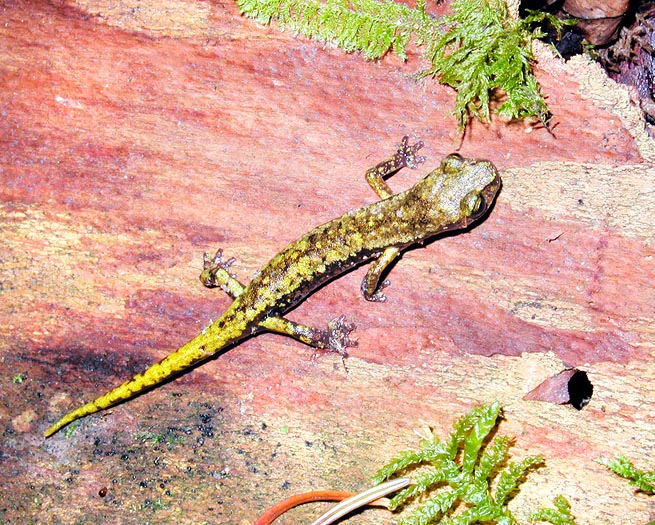
The Hydromantes italicus is one of the two Italian plethodontids © Giuseppe Mazza
The Greater siren (Siren lacertina) which may exceed the 90 cm, is without any doubt the oddest and best known member of the family, albeit it results much less understood and unveiled in its secrets than many other species of amphibians.
It lives in south-eastern USA, in not much deep ponds, swimming like an eel, of which it recalls the appearance, whisking away quickly, in case of danger, with energetic undulations.
The dorsal median line, which furrows the serpentiform body of the animal, renders its structure laterally com- pressed.
The median region of the trunk is marked by about forty furrows.
The tail, with circular section, is very broad at the base and then narrows in a point at the end, with two showy natatorial fins (dorsal and ventral).
More precisely, form the zoogeographic point of view, these animals are present in the fresh waters of the Atlantic part of USA (where they are rather frequent), from Old England to New Florida; in reality, they frequent the most diversified aquatic habitats.
As a matter of fact, they live not only in the ponds, the swamps and the still waters of the ditches, but also the swirling torrents and the rivers, as, among all amphibians, they are probably the fastest and most resistant swimmers. Some American zoologists have noted that these mysterious animals can move quickly in the water with speed peaks of 6,5 km/h.
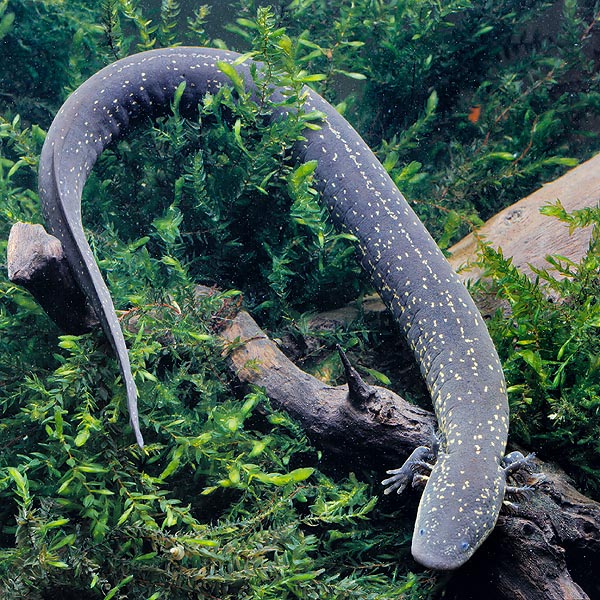
The Siren lacertian keeps the branchiae for all its life, but has lost its hind legs © Giuseppe Mazza
The greater sirens spend most of their life in water. Only during the night hours, at times, they reach the dry land, but they do not go too far from their reservoir.
They crawl through the vegetation, using their small forelegs, looking for food, which consists, besides other amphibians, also of insects and arthropods. When in the water, on the contrary, it is a smart hunter of small fishes.
Furthermore, this amphibian, unlike almost all his other relatives, if it feels to be menaced by too close, or is seized, does not hesitate to bite, producing minor but painful injuries. It is quite simple to keep this animal in captivity seen its little specialized diet.
It adapts very well, exceeding the 20 years of longevity, and carries on successfully his complete vital cycle.
It’s in this way that, in the past, the zoologist biologists have been able to study its biologic cycle and its reproductive modalities, which are however thought to be very different from those in the “wild”, where anyway it is very difficult to observe them, seen its solitary, reserved and elusive character.
In any case, from above it is known that the eggs, of big shape (about one centimetre of diameter), covered by a mucilaginous involucre, are laid singly, or in small groups, on the stones of the bottom or on the submerged vegetation. A congener of this species, the so-called Dwarf siren (Siren intermedia), about 40 cm long, lives in the south-eastern part of USA, Texas and northern Mexico. Not good as swimmer as the older sister, the dwarf siren frequents exclusively the still waters and the ponds rich in aquatic plants, nourishing of whatever sort of animals and releasing up to 500, and more, eggs. Various geographic races are known of the same.
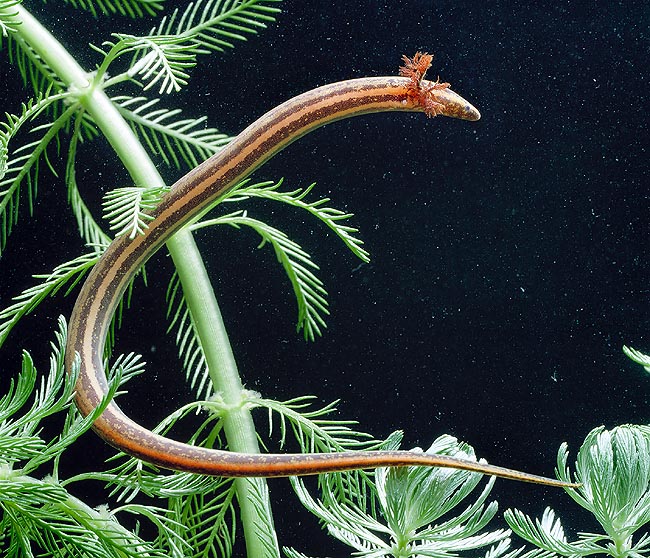
When the ponds dry up, the Pseudobranchus striatus shelters at 30 cm in the mud © Giuseppe Mazza
Finally, we will mention briefly, also due to the scarce information about this, to the other genus of Sirenidae the Pseudobranchus. First of all, these amphibians are characterized by much inferior dimensions than the real and proper sirens. The small forelimbs have only three toes. Like the greater siren, these amphibians have a colouration basically brownish-grey on the body, with small yellow spots scattered on the trunk and the limbs, but unlike sirens, they do have the sides run across by an irregular yellow band, with also the ventral side maculated in yellow. They like best the life in marshes and swamps.
The pretty Northern dwarf siren (Pseudobranchus striatus) has a slim and anguilliform body, which may reach the 25 cm, with showy lateral bands going from the head to the tail.
It is frequent in South Carolina, Georgia and Florida and lives on the bottom of the ponds, hunting, during the night, small crustaceans and insects. When they dry up, it can survive even for two months in dens dug under the mud, at a depth of about 30 cm.
